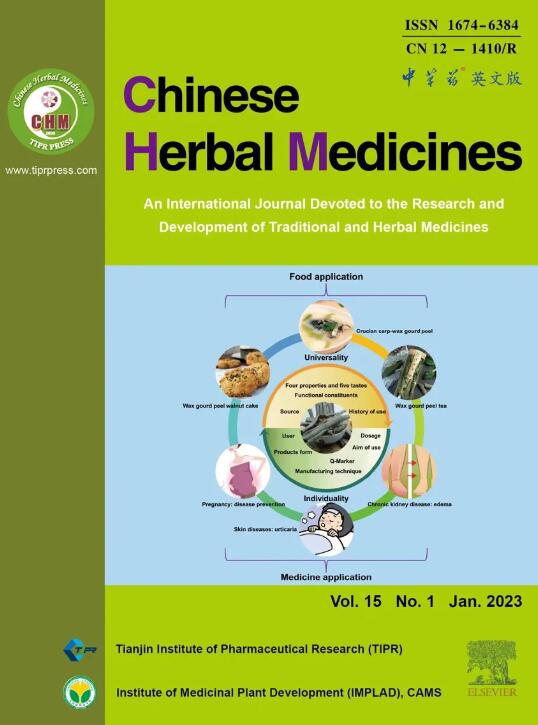Applications and challenges of DNA barcoding in rapid radiation groups: Rhodiola (Crassulaceae) as a case study
IF 4.7
4区 医学
Q1 CHEMISTRY, MEDICINAL
引用次数: 0
Abstract
Objective
Rhodiolae Crenulatae Radix et Rhizoma (Hongjingtian in Chinese, RCRR), the roots and rhizomes of Rhodiola crenulata and its application in the medicinal market is very chaotic. In this study, DNA barcoding database and identification engine of Rhodiola species were established, decoction pieces from the medicinal market were identified, and the application and challenges of DNA barcoding in the rapid radiation of Rhodiola species were analyzed. This study provides reference for the protection, rational development, and utilization of endangered resources within Rhodiola species.
Methods
A total of 50 original plant samples from 20 species of the genus Rhodiola from Hebei, Xinjiang, Tibet, Jilin, and other major production areas were collected. Theses samples cover the typical distribution area (Qinghai-Tibetan Platea) of Rhodiola species and other scattered alpine regions (Changbai Mountain, Taibai Mountain, Lushan Mountain, etc.), it encompasses all Rhodiola species with thick rhizomes in China. ITS2 and psbA-trnH barcode of Rhodiola database (BORD) were established and an identification engine named Rhodiola-IDE was developed. The stability and accuracy of the standard DNA barcoding database were evaluated using two datasets. Rhodiola-IDE identified 31 decoction pieces of RCRR from the medicinal material market.
Results
The BORD containing 1 532 sequences of 88 Rhodiola species has been established, and the identification efficiency results showed good accuracy and stability. According to the Chinese Pharmacopoeia (2020 edition), 23 samples (74.2%) were identified as authentic R. crenulata, while the rest of the marketed varieties were R. kirilowii, R. dumulosa, and R. fastigiata. The product label “Larger flower, Hongjingtian” was identified as R. crenulata. Samples labeled as “Smaller flower, Hongjingtian” were identified as R. crenulata, R. kirilowii, and R. fastigiata.
Conclusion
ITS2 and psbA-trnH barcodes can identify monophyletic groups represented by R. crenulata. However, for non-monophyletic species, it is necessary to collect as many samples as possible and combine them with multiple markers for joint identification. This study discussed the application and challenges of DNA barcodes in Rhodiola under rapid radiation conditions, providing a scientific basis for the rational development and utilization of Rhodiola varieties.
DNA条形码技术在快速辐射组中的应用与挑战:以红景天为例
目的红景天(Hongjingtian, RCRR),红景天的根和根茎及其在医药市场上的应用非常混乱。本研究通过建立红景天物种DNA条形码数据库和鉴定引擎,对药用市场上的饮片进行鉴定,分析DNA条形码技术在红景天物种快速辐射中的应用和面临的挑战。本研究为红景天濒危物种资源的保护、合理开发和利用提供参考。方法采集河北、新疆、西藏、吉林等主要产地红景天属植物20种50份原始标本。这些样品覆盖了红景天种的典型分布区(青藏高原)和其他分散的高寒地区(长白山、太白山、庐山等),涵盖了中国所有根茎粗的红景天种。建立了红景天数据库(BORD)的ITS2和psbA-trnH条形码,并开发了红景天- ide识别引擎。使用两个数据集评估标准DNA条形码数据库的稳定性和准确性。Rhodiola-IDE从药材市场中鉴定出31个RCRR饮片。结果建立了包含88个红景天种1 532个序列的BORD,鉴定效率结果具有良好的准确性和稳定性。根据《中国药典》(2020年版),23份样品(占74.2%)被鉴定为真品,其余上市品种为基里洛白、杜鹃白和尖白白。产品标签“大花,红荆天”鉴定为小木犀草。标记为“较小的花,红井田”的样品鉴定为crenulata、kirilowii和fastigiata。结论its2和psbA-trnH条形码可识别以小木犀为代表的单系类群。而对于非单系物种,则需要尽可能多地采集样本,并结合多个标记进行联合鉴定。本研究探讨了DNA条形码技术在红景天快速辐射条件下的应用及面临的挑战,为红景天品种的合理开发利用提供科学依据。
本文章由计算机程序翻译,如有差异,请以英文原文为准。
求助全文
约1分钟内获得全文
求助全文
来源期刊

Chinese Herbal Medicines
CHEMISTRY, MEDICINAL-
CiteScore
4.40
自引率
5.30%
发文量
629
审稿时长
10 weeks
期刊介绍:
Chinese Herbal Medicines is intended to disseminate the latest developments and research progress in traditional and herbal medical sciences to researchers, practitioners, academics and administrators worldwide in the field of traditional and herbal medicines. The journal's international coverage ensures that research and progress from all regions of the world are widely included.
CHM is a core journal of Chinese science and technology. The journal entered into the ESCI database in 2017, and then was included in PMC, Scopus and other important international search systems. In 2019, CHM was successfully selected for the “China Science and Technology Journal Excellence Action Plan” project, which has markedly improved its international influence and industry popularity. CHM obtained the first impact factor of 3.8 in Journal Citation Reports (JCR) in 2023.
 求助内容:
求助内容: 应助结果提醒方式:
应助结果提醒方式:


